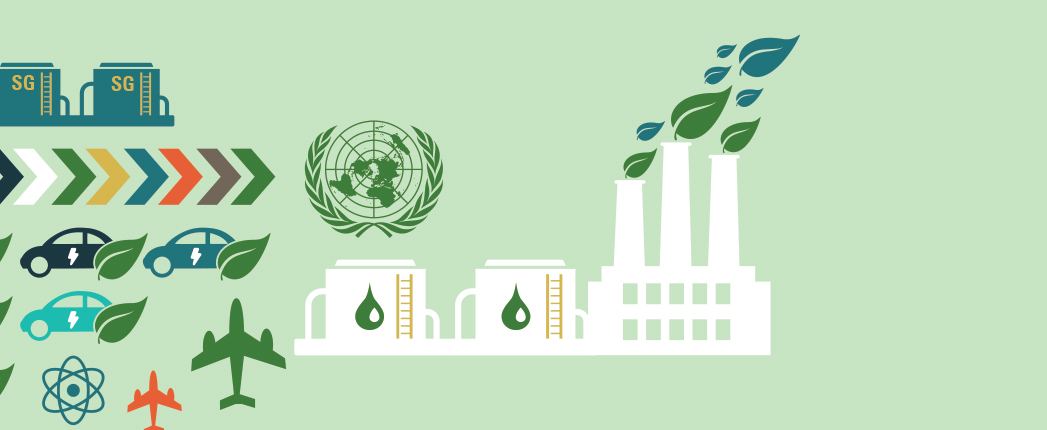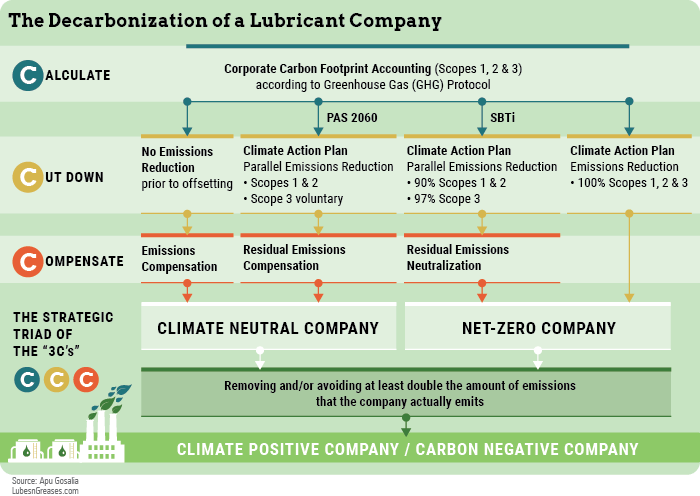
Apu Gosalia, industry expert adviser and partner in sustainability strategy, discusses whether climate neutrality is possible for lubricant companies as well as how these companies can meet their sustainability goals now and in the future.
“A climate-neutral lubricant player is a role model!” said Apu Gosalia. He elaborated: “At the very least, the preparation of an annual CO2 balance will soon gain the same importance in large, medium-sized and even small lube companies as the financial balance sheet already has.”
To Gosalia, lubricant companies with an established CO₂ balance (i.e. a corporate carbon footprint, or CCF), calculated according to a de-facto standard by a certified sustainability institution, give companies the correct tools to meet the requirements of their customers, the capital market, politics, society and the demands of the younger generations, while at the same time realizing the potential talents of the lubes industry.
Is a climate-neutral lubricant company an illusion?
Gosalia: On the contrary, a climate-neutral lubricant company is not an illusion but rather an institution—a role model! At the same time, it is a strategic goal that companies and organizations operating in the lubes industry must strive for and achieve, as the success of lube players is no longer judged by purely economic criteria. Ecological factors must be considered, too. What is an illusion, however, is the term “emission-free company.”
Why might emission-free companies be considered a thing of fiction?
Gosalia: Nowadays, unfortunately, the term “climate-neutral” is often confused with the term “emission-free” or is used interchangeably with the latter. This is often the reason for unjustified criticism; the keywords “greenwashing or “trade in indulgences” are often used in this context.
The same critics, however, overlook the fact that practically every activity leads to greenhouse gas emissions, and emission-free living is hardly possible for individuals and companies. Even fruit and vegetables from one’s own garden do not usually grow without emissions. They are at the end of a supply chain that transports seeds, fertilizer and gardening tools, causing emissions in the process. So those who are concerned about the lack of emissions-free production of lubricants falsely create the impression that such production is possible during blending processes.
How can lube companies become active in climate neutrality?
Gosalia: What is possible and necessary for lube companies would be to compensate for the unavoidable or not yet avoided emissions by investing in climate protection projects in parallel to their own CO₂ reduction and avoidance efforts. In this way they can become climate-neutral.
Can you explain climate neutrality in more detail?
Gosalia: Activities are considered climate-neutral if they do not put a strain on or pollute the climate or in other words, if they have no net-effect on the climate (neither negative nor positive) and do not create or cause any additional greenhouse gas emissions.
However, as explained before, practically every activity causes emissions. Still, climate neutrality in this respect can be achieved if CO₂ emissions are offset or compensated for by climate protection projects to the same extent they have been caused by the activities before. For the climate, unlike air pollution, it does not matter where greenhouse gases enter the atmosphere and where they are reduced. What is important is that global emissions are not increased anymore by human or corporate activities and that they are decreasing overall over time. Since CO₂ emissions affect the climate on a global level, it is ultimately irrelevant from a balance sheet perspective in which part of the world they are produced and where they are saved. Thus, if emissions are avoided to the same extent by investing in international climate protection projects, the balance for the climate is neutral again.
How does climate neutrality differ from similar definitions often used in this context (e.g. CO2-neutral, carbon-neutral, carbon negative, carbon positive, climate positive or net-zero)?
Gosalia: During the past couple years, the number of climate neutral claims by companies has risen drastically. Some companies making such claims faced legal complications and government regulations. The various yet similar terms may cause confusion about the intention of the different claims and how those claims can be understood. Therefore, a clarification is needed that allows for a classification of the terms.
As a first step, to claim any of the statuses listed above, it is important to properly calculate the greenhouse gas emissions (Scope 1, 2 and 3) created by an organization. This is typically done by applying the recognized Greenhouse Gas (GHG) Protocol Standard. Scope 1 includes direct emissions from company-owned and controlled resources, while Scope 2 comprises indirect emissions from the generation of purchased energy. Scope 3 are all other indirect emissions not included in Scope 2 that occur in the value chain, both upstream and downstream. Once the emissions are calculated, companies should start reducing those emissions. However, this is not a mandatory requirement to immediately become a climate-neutral company. The calculated emissions can initially be offset by purchasing the corresponding amount of emission certificates, regardless of parallel to a company’s own efforts to reduce emissions prior to offsetting. For one ton of emissions produced, one emission certificate must be purchased to become a climate-neutral company. This process of compensation can be achieved through carbon avoidance, which includes such activities as production of green energy through solar or wind parks, or carbon removals, which include Direct Air Capture with geological storage and nature-based solutions, like reforestation.
For the time being, there exists no de-facto standard that would clearly define how to reach climate neutrality. The PAS 2060 standard is the single standard that allows for an audit by external parties when it comes to climate neutrality claims. The standard asks for reduction measures to verify the respective company as climate neutral. A company must develop a Climate Action Plan that contains a commitment to climate neutrality and outlines a voluntary reduction strategy, which contains a time scale, specific targets for reductions, the planned means of achieving reductions and how residual emissions will be offset. Another standard on climate neutrality, the ISO 14068, is currently under development. It is supposed to provide clear definitions and parameters for CO₂ neutrality in the future and is planned to be released at the end of 2023.
Most climate neutral claims, however, are not based on climate neutrality standards and simply rely on the fact that the amount of purchased climate certificates equals the calculated emissions in the respective greenhouse gas emission balance.

Mostly used interchangeably with climate neutral in this regard are the terms CO₂ neutral and carbon neutral (which are synonyms). However, from a scientific standpoint the latter do not take into account other relevant greenhouse gases apart from CO₂. Most carbon footprint calculations (e.g. the GHG Protocol) factor in carbon dioxide equivalents, or “CO₂e,” which describe different greenhouse gases in a common unit.
More ambitious and demanding is the Science Based Target initiative (SBTi), which introduced its net-zero standard in late 2021. It requires companies to first reduce their Scope 1 and Scope 2 emissions by at least 90%. It also requires a reduction in Scope 3 emissions up to 97% compared to a base year, which should not be before 2015. Compensation measures are not counted toward the target fulfillment.
Once companies reach the defined reduction thresholds, they are allowed to neutralize their residual emissions—around 10% of the overall emissions determined in the base year. Neutralization can only be achieved through carbon removals. Unlike the concept of climate neutrality, carbon avoidance does not count toward achieving the target of becoming a net-zero company.
The terms climate positive and carbon negative can be used interchangeably, as they refer to the same activities. They mean that an activity goes beyond the net-zero or climate-neutral status by removing and avoiding more emissions (at least double the amount) than the company actually emits.
Carbon positive is how organizations sometimes describe climate positive and carbon negative. It’s mainly a marketing term and understandably confusing. It is strongly recommended not to use this term at all.
What factors do lubricant companies have to consider on their way to climate neutrality?
Gosalia: Lube companies should consider the strategic triad of the “3 C’s,” as I call them: calculate, cut down, compensate. To achieve this, the first thing to do is to measure the company’s CO₂ emissions (CCF) according to the de-facto standard of the GHG Protocol, as described above. The CO₂ balance plays a decisive role, because what you can’t measure, you can’t manage. What you can’t manage, you can’t minimize. A greenhouse gas balance creates transparency and enables lube players to identify the direct and indirect emissions in their company and along their value chain.
What should lubricant companies do next?
Gosalia: As mentioned before, the important thing is to reduce CO₂ emissions as far as possible in the next step or to avoid them completely. This can be achieved, for example, through higher energy efficiency, process optimization, switching to renewable energies or through combinations of these and other methods.
Parallel to this process, residual emissions can and should be compensated for through the investment in strictly certified climate protection projects in the developing countries of the so-called “global south,” so that the company’s emission balance at the end of each calendar year is climate-neutral. The added value for the environment from CO₂ compensation comes from the voluntary promotion of climate protection projects that would not be feasible without such additional income. This offsetting needs to be done in the first year after the initial determination and calculation of the CCF, without waiting until all internal optimization and emission reduction measures have been accomplished. After all, our time to proactively decarbonize the economy, the planet and our societies is literally running out, as the IPCC (Intergovernmental Panel on Climate Change) clearly stated earlier this year.
Per definition, a lube company does not necessarily have to reduce its own emissions before reaching carbon neutral status. However, it is clear that CO₂ compensation should accompany but not replace the continuous search by lube companies for reduction potential of their CO₂ emissions. Compensation alone will not save us, but it is a compulsory “bridge technology” to buy ourselves some time to intrinsically change, innovate and decarbonize procedures along the process and value chain of the lubricants industry and find new emission-saving technologies.
Read more from our Special Report: Can the Lubricants Industry Truly be Sustainable?
• Can the Lubricants Industry Truly be Sustainable? – Some critics are sceptical about the lubricants industry’s ability to operate in a sustainable manner. Others are hopeful that the industry can do its part to mitigate climate change.
• Pump Up the Policy – Lawmakers, regulators and standards agencies around the world are driving the transition to a low-carbon economy through a raft of policy initiatives. What kind of pressure will these policies put on lubricant industry players?
• No Longer Neutral About Climate: The Decarbonization of a Lubricant Company – Industry expert and sustainability adviser Apu Gosalia explains how lubricant companies can achieve climate neutrality.
Apu Gosalia is an expert and partner in sustainability and strategy. He heads the Climate Neutrality Council in the Senate of Economy and lectures at various universities. Apu is contributing editor for sustainability at Lubes’n’Greases.